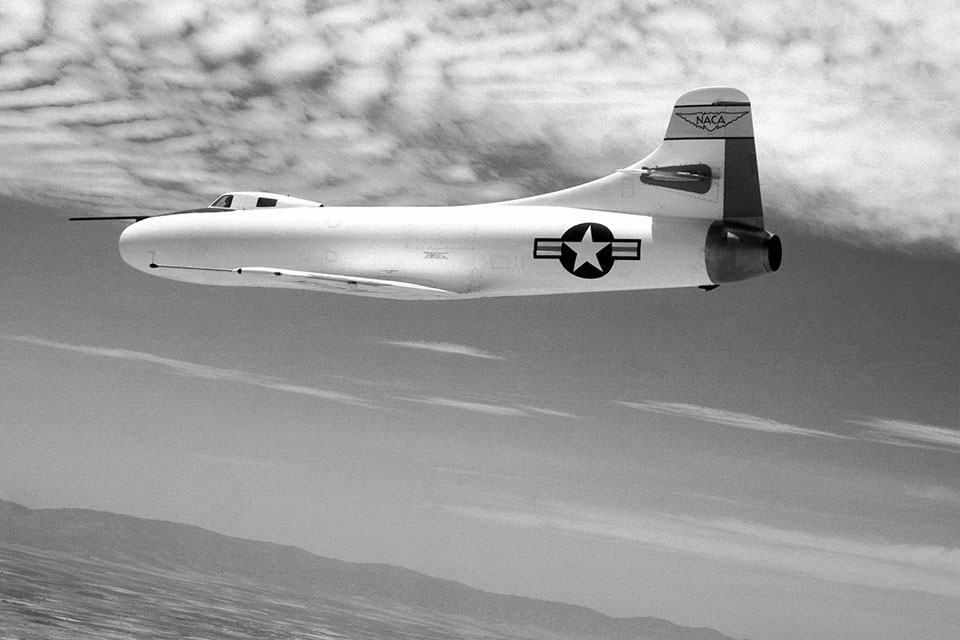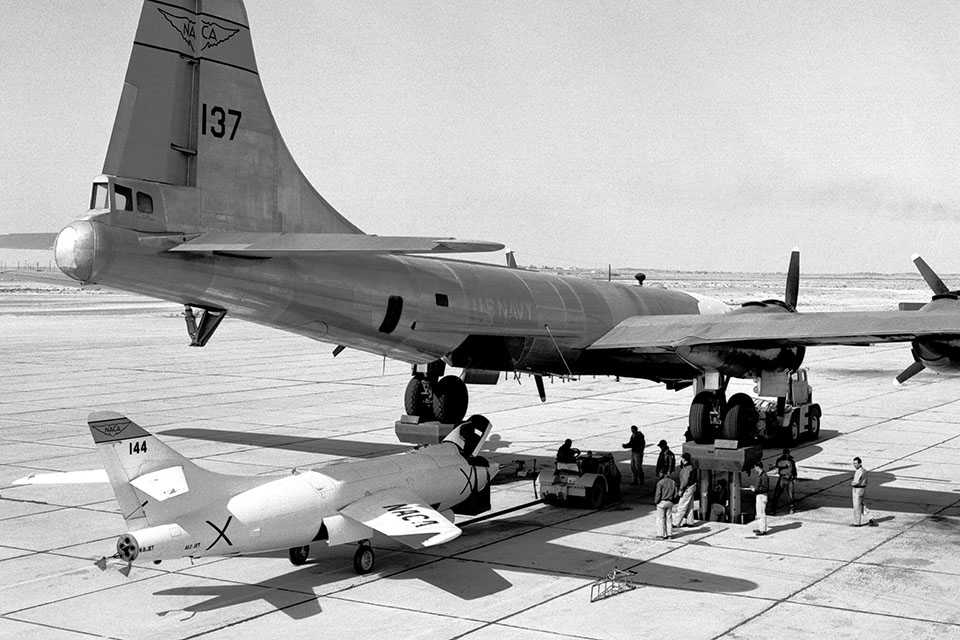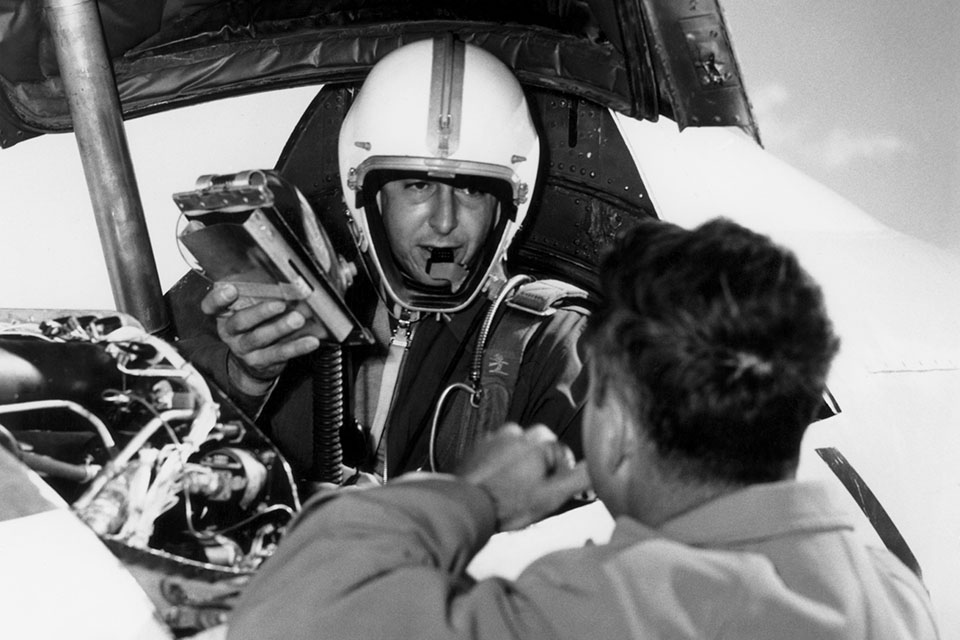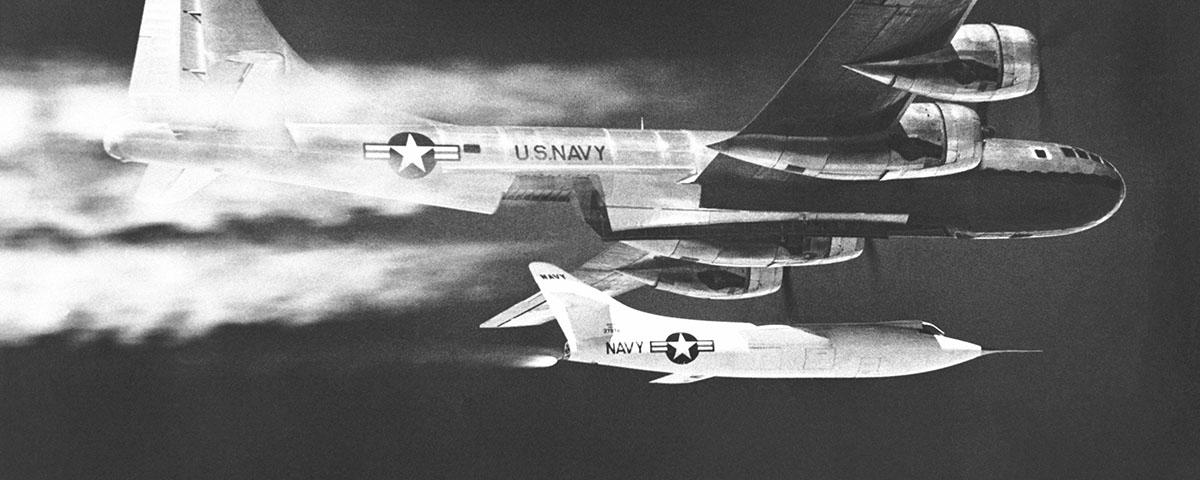How Scott Crossfield scored aviation’s double-sonic prize.
Sixty years ago, high above California’s Antelope Valley, a civilian research pilot flying a needle-nosed rocket airplane ushered in the age of Mach 2. The man was Scott Cross- field, flying for the National Advisory Committee for Aeronautics, and the plane was the aptly named Douglas Skyrocket. How the man, the plane and the normally publicity-shy NACA came to achieve one of aviation’s signature feats is among the most interesting episodes from the early supersonic era. As the fall of 1953 opened, America’s aviation community looked forward to celebrating the 50th anniversary of Kitty Hawk. American aircraft constituted the world’s gold standard, reflecting the nation’s impressive aviation infrastructure and an expansive research program overseen by NACA, predecessor to today’s NASA.
Over the previous decade, aviation had changed dramatically, the sweptwing becoming the iconic symbol of the new jet age. Sweptwings had been around since 1907, to self-stabilize tailless aircraft. But the high-speed sweptwing dated to a seminal (and largely overlooked) paper given by German fluid dynamicist Adolf Busemann at an international conference in 1935.
In 1945 NACA’s Robert T. Jones independently discovered the sweptwing’s high-speed advantages. Jones’ report met with skepticism until investigators stumbled across Nazi Germany’s investment in sweptwing aircraft and missiles. Afterward, sweptwing programs proliferated, particularly in the United States and the Soviet Union. The race to design operational sweptwing aircraft created a need for research data that led to Crossfield’s Skyrocket.
The Skyrocket sprang from an earlier Navy-NACA program to build a straight-wing transonic research airplane, the Douglas D-558 Skystreak. Designed by the legendary Ed Heinemann (father of the SBD dive bomber), the slender, jet-powered D-558 complemented the Army Air Forces’ supersonic rocket-powered Bell XS-1.

Then in 1945 engineers A.M.O. Smith and L. Eugene Root joined a Navy technical team scouring Germany. They returned determined to modify the D-558 to a sweptwing configuration, an idea already suggested by John Stack, NACA’s most influential research airplane advocate. Leaders of the Navy’s Bureau of Aeronautics (“BuAer”) swiftly concurred, authorizing three straight-wing D-558-1 Skystreaks, followed by three sweptwing D-558-2 Skyrockets.
Douglas completed the first of the three D-558-2s in late 1947. Though built like the D-558-1—from aluminum alloy framing, ribs and stringers covered by magnesium sheeting—it was radically different. Indeed, it looked like some science fiction rocket ship. Its sleek, bullet-like fuselage sprouted a gracefully tapered, 35-degree-swept anhedral wing and a sinuous vertical fin that supported a 40-degreeswept horizontal stabilizer. The tail featured powered stabilizer trim (for greater high-speed pitch control authority), and the pilot used a control yoke instead of a stick. It had tricycle landing gear, a jettisonable nose for pilot escape and both a jet and rocket engine.
Speeding the plane through the air were a small 3,000-poundthrust, gasoline-fueled Westinghouse J34 axial-flow turbojet and a four-chamber Reaction Motors LR-8 rocket engine fed by a hydrogen peroxide–powered turbopump. Each of the LR-8’s chambers produced 1,500 pounds of thrust, burning a mix of diluted alcohol (“walc”) and liquid oxygen (“lox”).
Its streamlined form hid a 1,100-pound instrument payload. Miles of pressure tubing and wires connected sensors sampling airflow at more than 400 locations on the wings and tail, and 900 strain gauges measured structural loads. An oscillograph recorded the data while ground observers radar-tracked the airplane as it flew.
On October 14, 1947, flying the Bell XS-1 (later X-1), Captain Charles E. “Chuck” Yeager took piloted flight through Mach 1. The first Skyrocket arrived at Muroc Army Airfield in California on December 10, completing its first flight on February 4, 1948, flown by Douglas pilot John Martin.
Douglas retained the first Skyrocket for company testing, but delivered the second to NACA’s Muroc research station. Turbopump delays left both aircraft flying on just the J34, so Douglas and NACA used JATO rockets to kick them into the air. Once aloft, they could barely reach Mach 0.87 (575 mph), and only in a dive.
The long-overdue turbopump finally arrived at year’s end, allowing Douglas to complete the third Skyrocket with both engines. On February 25, 1949, test pilot Gene May made its first rocket flight. On June 24, he flew it past Mach 1, recalling, “The flight got glassy smooth—quite the smoothest flying I had ever known.”
Air-launching the Skyrocket would clearly increase its performance, safety and research productivity. Accordingly, in November 1949, BuAer contracted with Douglas to modify the second and third D-558-2s for air launch. The jet engine and fuel tank on the second Skyrocket were replaced with increased rocket tankage, boosting its propellant capacity to 345 gallons of lox and 378 gallons of walc. (The third retained both engines.) BuAer procured a B-29 mothership, modifying and redesignating it in then-Navy fashion as the P2B-1S.
On September 8, 1950, the jet-and-rocket third airplane completed the type’s first air launch, flown by Douglas test pilot Bill Bridgeman. The all rocket second D-558-2 arrived back in the desert in November, but Bridgeman did not make its initial airdrop until January 26, 1951.
When he did, it was not without incident. Just before launch he noted falling propellant pressure and radioed: “No drop. This is an abort,” then set about shutting down the airplane’s systems. But the P2B-1S pilot had his thumb on the transmit key, and kept intoning the countdown. Bridgeman managed to reconfigure for launch, growling, “I told you not to drop me!” as the plane fell away. Fortunately the LR-8 ignited, and he reached Mach 1.28 at 41,000 feet (about 845 mph) before descending to land on the dry lake at Edwards Air Force Base, as Muroc had been renamed.
During subsequent testing, he reached Mach 1.88 at 66,000 feet (1,260 mph), and on his last flight on August 15 attained 79,494 feet, an unofficial world record. Douglas returned the plane to NACA in mid-August 1951. Technicians stripped all unnecessary markings save for the agency name, its yellow-and-black fin-flash and its NACA serial number, 144.
Many wondered if NACA would try to reach Mach 2, given the risks. Bridgeman, a superb pilot, had encountered wild instabilities threatening his ability to control the plane. One discovery was the influence of G load during transition from climb to level flight. Engineers had recommended a 0.25G push-over to get higher acceleration, but this resulted in violent rolling. Bridgeman found pushing over at 0.8G reduced the roll rates to manageable levels.
Any attempt to go faster clearly risked disaster—but NACA’s Scott Crossfield accepted the challenge. A former Navy fighter pilot with a Master’s degree in aeronautical engineering, he had joined NACA’s Edwards contingent in 1950, recalling: “Howard Hughes couldn’t afford the airplanes that I got paid to fly….[You’d have] an X-1 to fly for breakfast, X-4 for lunch and a D-558-2 in the afternoon… where could you get it better than that?”
In 1951 Crossfield made his first familiarization flights in the all-rocket 144, following these with detailed supersonic investigations to Mach 1.68 (1,082 mph) that left him convinced he could safely exceed Mach 2, given the right flight plan and preflight preparation. Indeed, he believed the biggest hurdle was whether NACA would condone a Mach 2 flight. Traditionally, NACA worked behind the scenes, leaving record-setting to the military services. There was already a strong rivalry between the Air Force–sponsored X-1 and the Navy-sponsored D-558-2, and it grew stronger still as each edged closer to Mach 2.
Two new X-1s, the X-1-3 and the X-1D, had arrived at Edwards in 1951. Each could exceed Mach 2, and it seemed just a matter of time before the record fell. But explosions destroyed both, fortunately without loss of life (though Bell pilot Joe Cannon was badly injured). Their loss meant the Skyrocket remained in the running for Mach 2.
In early 1953, Bell returned to Edwards with the new X-1A, flown by Jean “Skip” Ziegler. Even then, NACA pressed on with the Skyrocket, as Crossfield evaluated its supersonic roll stability at increasing angles of attack—the area where Bridgeman had so much trouble. But the Navy was not so blasé. Conscious of the publicity value, BuAer requested NACA’s permission to make a series of high-altitude, high-speed flights. Dr. Hugh L. Dryden, the agency’s director of aeronautical research, readily assented: The Navy had started the D-558 program; its pilot would not be a NACA airman, and, furthermore, NACA’s leadership had a soft spot for the Navy for having supported its creation via a naval appropriations act back in 1915.
Thus in the summer of 1953, Lt. Col. Marion Carl, a Marine fighter ace who had set a Skystreak speed record in 1947, arrived at Edwards to pilot the D-558-2. By the time he left, he had flown seven times, setting an altitude record of 83,235 feet while wearing an experimental pressure suit. But even he could not break Mach 2, reaching just Mach 1.728.

So attention returned to the X-1A, now proven and a contender for the Mach 2 crown. But fate stepped in again, tragically. After finishing his X-1A testing, Skip Ziegler had returned to Buffalo to shepherd along Bell’s X-2, a troubled Mach 3 design. On May 12, 1953, cruising over Lake Ontario mated to its Boeing EB-50 mothership, the second X-2 blew up, killing him and Superfortress crewman Frank Wolko. Brilliant piloting by William Leyshon and D.W. Howe saved the EB-50, which was blown upwards 500 feet and critically damaged. Bell immediately grounded all its rocket planes; the X-1A did not fly again until late November.
The Skyrocket now returned to center stage—and with an ace up its sleeve. Researchers had discovered that as the aircraft climbed, decreasing atmospheric pressure caused its exhaust to expand, impinging on the rudder and increasing rudder control forces and hinge moments. As a cure, BuAer furnished thrust chamber nozzle extensions that also increased total thrust by roughly 7 percent. On September 17, Crossfield reached Mach 1.85 at 74,000 feet. On October 14, 1953, the sixth anniversary of Chuck Yeager’s first supersonic sojourn, he reached Mach 1.96 (1,262 mph), just 25 mph short of Mach 2.
Would NACA now break its “stay out of the limelight” tradition and fly through Mach 2?
Crossfield believed it would—if pushed. He approached a Navy civilian at Edwards, telling him Dryden wouldn’t condone a Mach 2 flight without outside influence. “The pressure for this flight,” the pilot stressed, “must once again come from the Navy direct to Dr. Dryden.”
The bold end-running gambit worked; word came down that NACA headquarters would permit a flight attempt to exceed Mach 2. In preparation for the publicity that would ensue, the agency sent Walter Bonney, its head of public relations, to the high desert. Program engineers, technicians and planners prepared for the flight. “The NACA Skyrocket team,” Crossfield recalled, “was unbeatable.”
Nothing was left to chance. Capitalizing on previous experience and the extra thrust furnished by the nozzle extensions installed on the LR-8 engine, project engineer Herman O. Ankenbruck drew up a special flight profile for the mission, predicated on launching over the western Antelope Valley and accelerating eastward (to take advantage of prevailing winds), with Crossfield climbing to 72,000 feet before pushing over. Still, it would be close. “We knew that we had a very marginal situation,” Crossfield said in 1998.“We were determined that if we did everything just right, we could thread that needle right out there where Ankenbruck had calculated it, and come out with about Mach 2.03 or something like that.”
Technicians taped all seams, waxed the airplane and polished it to a high gloss. Jack Russell, Edwards’ leading rocket airplane technician, even curved the Skyrocket’s aluminum propellant jettison pipes so that the engine’s hot exhaust would melt them, further reducing weight. The night before the flight, its ground crew cold-soaked the alcohol to add as much as possible, continually topping off the supercold liquid oxygen as well, hoping to get 200 seconds of burn time from the LR-8.
As morning dawned on Friday, November 20, 1953, the plane was brimming with propellant and so frigidly cold that a valve froze, causing supercold hydrogen peroxide to suddenly spray out and envelop NACA mechanic Jack Moise. Another mechanic, Gilbert Kincaid, immediately hosed down Moise, preventing serious injury. Later, sitting in a flightline clinic, Kincaid casually remarked to Crossfield that he felt “quite warm,” despite the desert’s early morning chill. Crossfield then realized that Kincaid— whose pants had been soaked by the “very vicious” peroxide—was being slowly cooked by peroxide in the fabric. He immediately stripped off Kincaid’s pants, sparing the astonished mechanic potentially life-threatening burns.
The incident delayed takeoff until midmorning, when the P2B-1S roared down Edwards’ South Base runway and into the air. As the mothership slowly climbed to launch altitude, Crossfield entered the Skyrocket’s cockpit and readied it for flight. Despite having a bad case of flu, he recalled, “I was on the edge of my seat.” When it was time to pressurize the Skyrocket’s cockpit, he wisely first inserted a cork in the compressed air outlet, easing it out so that the air would leak out slowly, and not so rapidly as to induce a painful sinus block that might force cancellation of the flight. After further final checks, Superfortress pilot Stan Butchart intoned the drop countdown and launched Crossfield into the bright desert sky.
The LR-8 engine had four separate switches, one for each chamber. Crossfield flipped them in rapid succession, and with the Skyrocket at full thrust, outran an F-86 chase plane. Trailing a broad white contrail, the D-558-2 arced upward into the dark blue of the stratosphere. Crossfield carefully followed the “delicate knife-edge” of Ankenbruck’s flight profile. He gently began his push-over as he neared 72,000 feet, and the Skyrocket responded without protest, following a parabolic course that ended with it diving earthward, still under full power of its rocket engine.
The cold-soaking had worked; so had Ankenbruck’s flight plan and Crossfield’s airmanship: 144 was in the precise block of space it needed to be in. The Skyrocket was heading downhill under gravity assist and accelerating, with seconds of fuel yet remaining. It was high enough that dynamic pressure was still low, hence drag would not prematurely retard its speed.
As Crossfield watched jubilantly, the Machmeter edged past 2.0. Behind him, the engine finally starved itself after an incredible 207 seconds. The Skyrocket was at 62,000 feet and Mach 2.005, 1,291 mph. Upon entering the lower atmosphere, it quickly slowed. Descending through 15,000 feet over the dry lake, he executed a victory roll. Twelve minutes after the Skyrocket had dropped from the P2B-1S, its wheels stopped rolling on the hard playa lakebed.

Crossfield’s record lasted less than a month, for the X-1A was back, and Yeager was eager to fly it. The next day, November 21, Yeager checked it out, reaching Mach 1.15. On December 2, he reached Mach 1.5. Then, on the 8th, he flew to Mach 1.9 at 60,000 feet. On December 12, in arguably the wildest flight a test pilot ever survived, he reached Mach 2.44, 1,612 mph, at 74,200 feet. Then the X-1A coupled abruptly, rolling and yawing out of control, tumbling 50,000 feet into an inverted subsonic spin, its motions so violent that Yeager’s helmet cracked the canopy’s inner shell. Battered and groggy, he recovered into level flight at 25,000 feet over the Tehachapi Mountains, gliding back to Edwards. His safe return was a testament both to his phenomenal piloting skills and the X-1A’s rugged structure.
The D-558-2 never again approached Mach 2, Crossfield’s spectacular flight constituting its high point. NACA retired the three Skyrockets in 1956, and all are exhibited today. Crossfield’s 144, fittingly, hangs in the Smithsonian’s National Air and Space Museum, its lines still as exciting and futuristic as they were when it first flew.
The mysterious explosions that claimed the X-1-3, the X-1D and the second X-2 eventually claimed the X-1A as well, fortunately without further injury. More thorough analysis traced the cause to a treated gasket material that decomposed, and then, if frozen (as by supercold lox) between flanges, could detonate if suddenly jolted (as by tank pressurization). After it was replaced, no further explosions occurred.
As for Crossfield, his dedication to the proposed X-15 hypersonic research airplane caused him to leave NACA for North American Aviation, where he shepherded it through its development and contractor testing, piloting it to Mach 2.97 (1,960 mph) at 88,000 feet and even throwing in a spectacular transatmospheric roll (see “Across the Hypersonic Divide,” July 2012). Afterward he worked on various North American missile and space projects, including Apollo. In 1967 he joined Eastern Airlines as a vice president for research and development, pushing for greater acceptance of STOL and regional aircraft. He joined the House Committee on Science and Technology in 1977, working with Congress until retirement in 1993. In his early 80s, he undertook gliding trials of replica Wright gliders built by K flight, remaining active in consulting and en Hyde for the centennial of powered aerospace advocacy—particularly for hypersonics—until his death on April 19, 2006. That day, as he was flying home after giving a lecture to officers at Maxwell AFB, a violent storm tore his Cessna 210 apart. He thus died in flight, at age 84, deeply mourned by the global aviation community, which rightly hailed him as a visionary who had always looked beyond the horizon.
Double-sonic flight is now 60 years old. Tens of thousands of aircrews and passengers have flown beyond it: some G-suited, helmeted and masked; others more casually attired, even idly sipping their cognac as Concorde’s cabin Machmeter edged up and over Mach 2. A very few have transited through it on the way to and from space, riding in capsules such as Mercury, Gemini, Apollo and Soyuz, or in the thundering space shuttle. But it is worth remembering that Scott Crossfield and the Douglas Skyrocket preceded them all.
Dick Hallion is a former U.S. Air Force historian and the author of numerous books on aviation history. For further reading, he recommends: Always Another Dawn: The Story of a Rocket Test Pilot, by A. Scott Crossfield with Clay Blair Jr.; The Lonely Sky, by William Bridgeman and Jacqueline Hazard; and Toward Mach 2: The Douglas D-558 Program, edited by J.D. Hunley.
Originally published in the January 2014 issue of Aviation History. To subscribe, click here.





